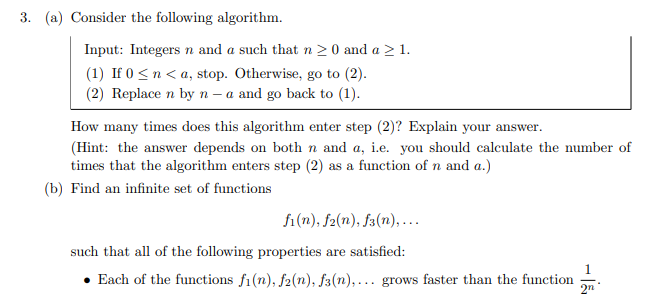3. (a) Consider the following algorithm. Input: Integers n and a such that n > 0 and a > 1. (1) If 0
3. (a) Consider the following algorithm. Input: Integers n and a such that n > 0 and a > 1. (1) If 0
Computer Networking: A Top-Down Approach (7th Edition)
7th Edition
ISBN:9780133594140
Author:James Kurose, Keith Ross
Publisher:James Kurose, Keith Ross
Chapter1: Computer Networks And The Internet
Section: Chapter Questions
Problem R1RQ: What is the difference between a host and an end system? List several different types of end...
Related questions
Question

Transcribed Image Text:3. (a) Consider the following algorithm.
Input: Integers n and a such that n 20 and a > 1.
(1) If 0 <n< a, stop. Otherwise, go to (2).
(2) Replace n by n - a and go back to (1).
How many times does this algorithm enter step (2)? Explain your answer.
(Hint: the answer depends on both n and a, i.e. you should calculate the number of
times that the algorithm enters step (2) as a function of n and a.)
(b) Find an infinite set of functions
fi(n), f2(n), fa(n), ….
such that all of the following properties are satisfied:
1
• Each of the functions f1(n), f2(n), f3(n), .. grows faster than the function
2n

Transcribed Image Text:grows faster than each of the functions fi(n), f2(n), f3(n),....
• For every integer i > 2, the function f:(n) grows faster than the function fi-1(n).
The function
2n
Note: you must write down formulas for your functions (in terms of n) and prove that
your functions have the required properties.
(If you do not remember what "grows faster" means, see Definition 4.5 in the coursebook.)
Expert Solution
This question has been solved!
Explore an expertly crafted, step-by-step solution for a thorough understanding of key concepts.
Step by step
Solved in 2 steps

Recommended textbooks for you

Computer Networking: A Top-Down Approach (7th Edi…
Computer Engineering
ISBN:
9780133594140
Author:
James Kurose, Keith Ross
Publisher:
PEARSON

Computer Organization and Design MIPS Edition, Fi…
Computer Engineering
ISBN:
9780124077263
Author:
David A. Patterson, John L. Hennessy
Publisher:
Elsevier Science

Network+ Guide to Networks (MindTap Course List)
Computer Engineering
ISBN:
9781337569330
Author:
Jill West, Tamara Dean, Jean Andrews
Publisher:
Cengage Learning

Computer Networking: A Top-Down Approach (7th Edi…
Computer Engineering
ISBN:
9780133594140
Author:
James Kurose, Keith Ross
Publisher:
PEARSON

Computer Organization and Design MIPS Edition, Fi…
Computer Engineering
ISBN:
9780124077263
Author:
David A. Patterson, John L. Hennessy
Publisher:
Elsevier Science

Network+ Guide to Networks (MindTap Course List)
Computer Engineering
ISBN:
9781337569330
Author:
Jill West, Tamara Dean, Jean Andrews
Publisher:
Cengage Learning

Concepts of Database Management
Computer Engineering
ISBN:
9781337093422
Author:
Joy L. Starks, Philip J. Pratt, Mary Z. Last
Publisher:
Cengage Learning

Prelude to Programming
Computer Engineering
ISBN:
9780133750423
Author:
VENIT, Stewart
Publisher:
Pearson Education

Sc Business Data Communications and Networking, T…
Computer Engineering
ISBN:
9781119368830
Author:
FITZGERALD
Publisher:
WILEY